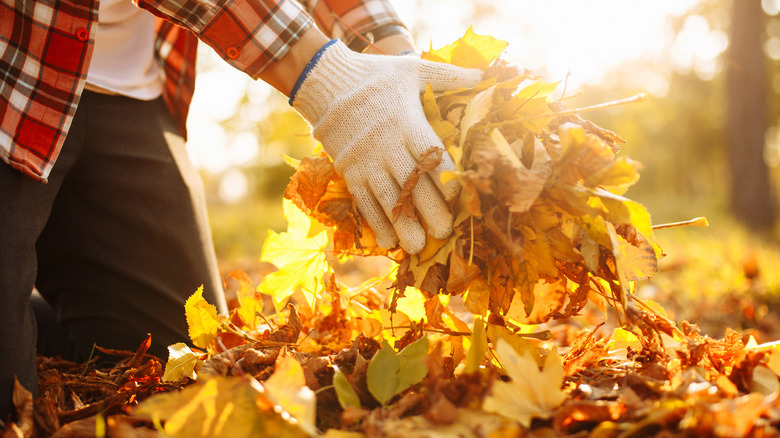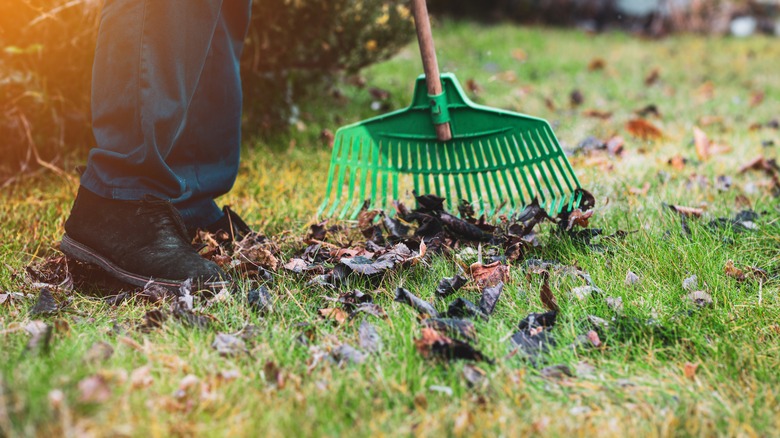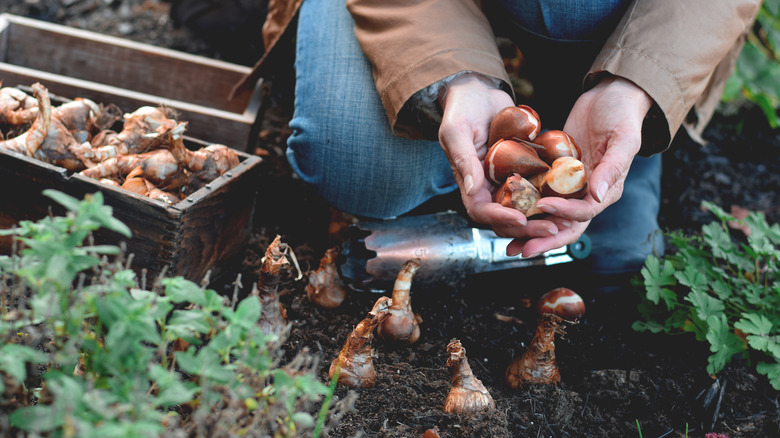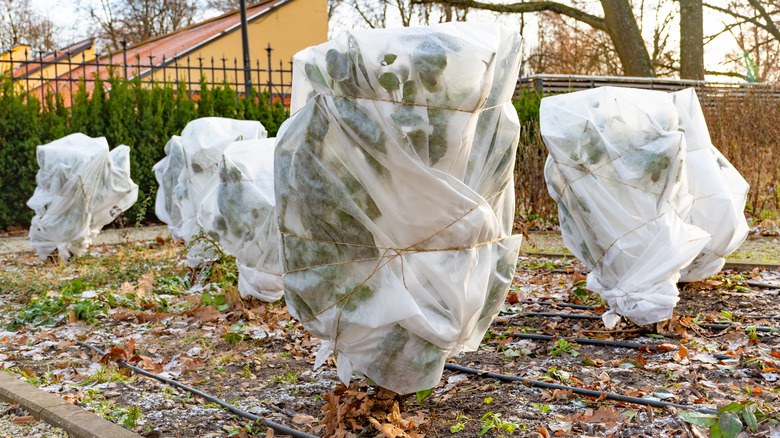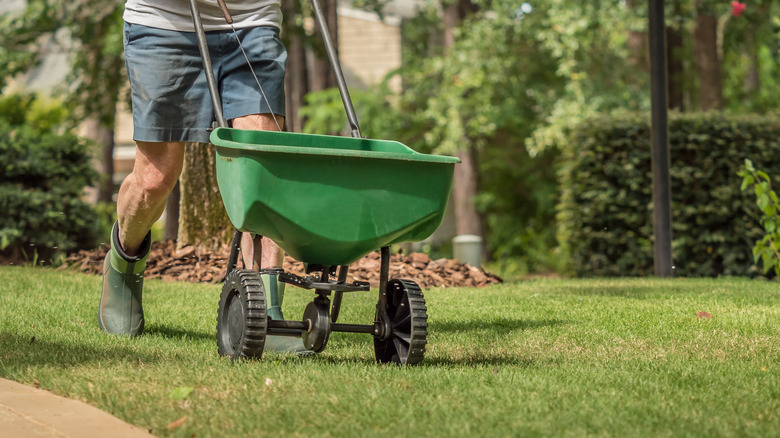5 Landscaping Mistakes To Avoid This Fall
As the leaves turn colors and the temperatures drop, landscaping might seem like a task you can put behind you until next season. Autumn sparks a time of year when most plants go into hibernation and stop growing, explains Jobes. This includes grass which will no longer need to be cut every weekend. However, this natural seasonal change does not mean your lawn care duties are over. There are many things you still should do to prepare your lawn for winter and set it up for success for the next growing season.
In between the harvest festivals, trick-or-treating, and visits to the pumpkin patch, many homeowners, unfortunately, make the same landscaping mistakes every year. These lapses can cost your plants months of growing and essential nutrients. Fall is one of the best times of year for some of the most crucial yard work you can do. Here are the most common mistakes to avoid and what you should do instead to keep your lawn happy and healthy.
Ignoring the leaves on the ground
The most iconic part of autumn is the beautiful foliage turning from luscious green to warm browns and brilliant yellows, oranges, and reds. These leaves eventually fall to the ground, where kids play in them and dogs get them stuck in their fur. Although taking pictures on lawns littered with fallen leaves is fun, it's crucial to not just leave them there. When leaves are ignored and left to cover the grass, they can smother the plants beneath them, according to the University of Minnesota. Additionally, this excess of leaves during the winter and spring will invite destructive pests such as voles, moles, and mice to wreak havoc on your landscaping.
When cleaning the leaves around the yard, homeowners may also make the mistake of bagging them up and throwing them away. Independent Tree explains that this adds a tremendous amount of unnecessary material to landfills. Leaves are a fantastic natural fertilizer and mulching tool (via Joe Gardener). While you don't want them lying around wherever they please, you can save money and waste by redistributing them throughout your landscaping. Use them to mulch around perennials, trees, and shrubs to protect the roots from the harsh winter and add nutrients back into the soil for a successful growing season next year.
Not planting for spring
It sounds backwards to consider planting a garden in the fall. This is the time of year things are dying or going dormant, after all. However, fall is the best time to plant many flowers, shrubs, and trees, according to Washington State Community Associations Institute (WSCAI). Often it's the time of year when rainfall is high and temperatures cool down; this environment is perfect for root development. It's also beneficial for transplanting because it reduces the amount of shock plants experience, which, in turn, promotes healthier plants in the spring.
Many flower bulbs can also be planted in the fall, and the cooler weather will encourage them to go dormant. When the warmer temps in spring wake them up, you'll have a flush of pretty colors to enjoy that require zero effort early in the year. According to Sunset, some of the best flowers to plant in the fall are geum, rudbeckia triloba, annual phlox, and dianthus. These plants grow even better when given a winter in the ground, and usually grow taller and stronger stems than those planted in spring.
Incorrect plant care
After a season of growth and wild gardens, it might seem tempting to chop down everything in your garden to ground level. It would clean up the yard and feel light, a fresh start for next season. However, this can damage many plants and possibly kill them or stunt their future growth. For example, ornamental grasses should be left as is over the winter and then cut back to about 6 inches above the ground in later winter or early spring, recommends Birds and Blooms.
Similarly, fall is not the time to be pruning spring flowering shrubs. Pruning these plants in the fall can cause a lot of damage to the plant and reduce the amount of growth and number of blooms it will produce next season. Per Pure Wow, for example, forsythia bushes should be left alone in the fall. Once they are done blooming in the spring you can prune them back as necessary.
Another common mistake is failing to covering young trees. According to Davey, protecting young and newly planted trees from harsh winter weather is vital to their survival. The tree experts suggest watering these plants deeply up until the weather turns frosty. Then cover the tree trunk and the canopy with burlap and lay a heavy mulch around the base to protect the roots.
Skipping extra lawn care
Just because the grass has stopped growing doesn't mean you're done with it. According to WSCAI, fall is when grass root systems are growing like crazy. It's crucial to fertilize your lawn during this time of year so it has what it needs to strengthen itself and survive the winter. When done right, these chores will give your grass the boost it needs to return stronger and greener in the spring. Scotts suggests feeding your lawn twice in the fall. Once in the early days of autumn and a second time six to eight weeks after the first feeding.
Over-seeding the lawn is another key element of healthy grass. Kemko Lawn Service says you should cut the grass as low as possible, rake away debris, and then over-seed the lawn. Over-seeding is a technique where you distribute grass seed on top of your existing grass. This will help thicken your lawn and improve it's overall health. Fertilizing and over-seeding are two factors that will boost your grass into being the thickest and healthiest it's ever been. Your neighbors are sure to be jealous!
Skipping tool cleaning before storing
Colder and shorter days means most of us aren't nearly as productive or motivated during the winter. But before you bust out those comfy pants and queue up a Netflix marathon, there's one last thing you need to do. As you finish up with the rest of your fall lawn chores, remember to care for the tools you've used all season long. Tools left dirty and unattended will likely not be much help next season.
The lawn mower has a dirty job that causes a lot of dirt, grass clippings, and stick debris to get caught in its mechanisms. To ensure it will work properly next summer, prepare your lawn mower for winter by giving it a good cleaning and taking it to the mechanic for a tune-up (via Popular Mechanics). All that dirt sitting for months will deteriorate the machine, and you won't get as many years out of it as a result. Since these aren't cheap items, you'll want to ensure you care for them as best you can.
Other garden tools such as rakes, shovels, pruning sheers, and weed whackers will need some TLC as well, according to HGTV. Removing any dirt, sap, and rust is the first step. Next, you can use a bucket of soapy water and a scrub brush to clean them up. This takes little time, and your tools will thank you next spring.
